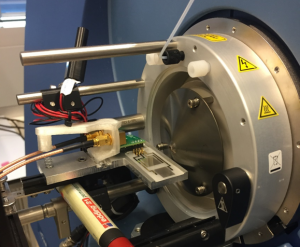
My name is Samantha Miller, and I am a Colorado State University graduate student researching in Amsterdam as a part of the Cultural Heritage Science Research funded by the National Science Foundation. As a participant in this International Research Experience for Students (IRES), my work is focused on the chemistry of art conservation. I particularly enjoy this field because it brings together both art and science. By unifying the two, this work defies the stereotypical expectation that the two must be in constant rivalry in order to flourish. My Dutch mentor, Dr. Klaas Jan van der Berg, is a senior conservation scientist and has worked closely with me as I apply my background in analytical chemistry to the analysis of twentieth century oil paints.
Although the old adage “as interesting as watching paint dry” sarcastically illustrates the process as passive and mundane, a number of processes are occurring at the molecular level which alter the chemical composition of the paints. Common drying oils such as linseed and safflower oil are mixed with artists’ pigments and later undergo a series of autoxidation reactions in which triacylglycerides form a crosslinked polymer network as the paint dries. The presence of tri-, di-, and mono- glycerides can be monitored using Mass Spectrometry, a powerful technique that separates ions based on their mass-to-charge ratio. By identifying the presence of these different fatty acids, along with other key compounds such as palmitic acid, stearate, linoleic acid, oleic acid, etc., it’s possible to construct some preliminary commentary on the age of the oil paint as well as the conditions in which it aged.

My favorite part of chemistry is working with the instrumentation. Obtaining the spectra of different oil paints imparts a more poetic end to the passive drying process. By the end of my tenure here in Amsterdam, I hope to demonstrate that reproducible data can be obtained not only using electrospray ionization (ESI) mass spectrometry, but surface acoustic wave nebulization (SAWN) mass spectrometry as well. Just as the name implies, electrospray techniques use differential voltages across directing cones to generate a gentle stream of ions that pass into mass spectrometer, in our case, a quadruople time-of-flight spectrometer. SAWN uses an applied voltage to generate a standing wave whose energy is transferred to the analyte. Once a threshold energy is reached, the analyte is nebulized into a plume which directed into the mass spectrometer. Preliminary tests have shown that SAWN requires much less volume and adds the additional benefit of removing the ever temperamental injection equipment of ESI methods. Eliminating the pumps, capillary tubes, and injection syringes not only lowers the possibility that a faulty part will slow the experiment, but also the probability of introducing contaminants. The techniques differ only in the way the oil paint is ionized, and if SAWN proves to be a successful method, then hopefully the Rijksmuseum will be able to apply this softer and quicker ionization method to future oil paint samples as well.
As glamorous and photogenic as the research experience has been, the most enjoyable part about working at the Rijksmuseum and Amsterdam is collaborating with fellow scientists. Walking through the main hall of the Ateliergebouw or the University Science Park, it’s easy to see that everyone is absorbed in their work. Yet, beneath the lab coats or behind the monitors are people who share a common passion for both art and science. The scientific community here in Amsterdam has a tangible awareness that they are working towards something greater than their own conservation project or publication. Each office and laboratory I pass reminds me of a different gallery in an art museum; Each is littered with vestiges of their specialized field: spectroscopy, spectrometry, rheology, proteomics. Everyone represents a different facet of science through their approach to conservation. It’s humbling to think that together, the individual efforts, failures, and successes somehow combine to let national artifacts live on for a new audience to appreciate and treasure the way we have.